Earl of Desmond
| Earldom of Desmond held with Earldom of Denbigh | |
|---|---|
 Arms of the Fitzgerald Earls of Desmond (for arms of the current Earl, seeEarl of Denbigh) | |
| Creation date | 1329(1st creation) 1600(2nd creation) 1619(3rd creation) 1622/1628(4th creation) |
| Created by | Edward III(1st creation) Elizabeth I(2nd creation) James VI and I(3rd creation and 4th creation (right on reversion)) Charles I(4th creation - confirmation of possession) |
| Peerage | Peerage of Ireland |
| First holder | Maurice FitzGerald, 1st Earl of Desmond |
| Present holder | Alexander Feilding, 12th Earl of Denbigh, 11th Earl of Desmond (4th creation) |
| Heir apparent | Peregrine Feilding, Viscount Feilding |
| Subsidiary titles | Viscount Feilding Viscount Callan Baron Feilding of Newnham Paddox Baron St Liz Baron Fielding of Lecaghe |
| Extinction date | 1582(first creation) 1601(second creation) 1628(third creation) |
| Seat(s) | Newnham Paddox House |
| Motto | Crescit sub pondere virtus(Virtue increaseth under oppression) |
Earl of Desmond(Irish:Iarla Dheasumhanmeaning Earl of SouthMunster) is a title of nobility created by the English monarch in thepeerage of Ireland.[1]The title has been created four times. It was first awarded in 1329 toMaurice FitzGerald, 4th Baron Desmond,aHiberno-Normanlord in Southwest Ireland, and it was held by his descendants until 1583 when they rose against the English crown in theDesmond Rebellions.Following two short-lived recreations of the title in the early 1600s, the title has been held since 1628 by theFeilding familyofWarwickshire,England. The current holder isAlexander Feilding, 12th Earl of Denbigh and 11th Earl of Desmond (4th creation).
Summary of history of the title
[edit]The Munster Desmonds were a cadet (junior) branch of the powerfulFitzGerald dynastywho came to Ireland from Wales as part of the 12th centuryAnglo-Norman invasion.Over the following centuries, the FitzGeralds famously assimilated themselves in Ireland, and, in the late 16th centuryTudor conquest of Ireland,they took arms against the Protestant English Crown in theDesmond Rebellions.As a result, the family's estates were confiscated, the earl beheaded and the title suppressed.
The English government imprisonedJames FitzGerald,the eldest son of the last earl, in the Tower of London for decades. However, in 1600, during theNine Years War,in an attempt to pacify the people of Munster, James was freed and title recreated for him though without right of inheritance. The people of Munster refused to accept the new Earl - a Protestant - and James died a year later in obscurity.
The third creation was in 1619 forRichard Preston,a favourite ofJames I:Preston had married the daughter and heiress of the10th Earl of Ormond,neighbour, relative and enemy of the Munster Desmonds. Preston died without male heir and - before Preston's death - James I decided the Desmond title should be subsequently awarded to George Feilding, a nephew of another of the King's favourites. The idea was that George would marry Preston's daughterElizabethand thereby inherit lands in Ireland.
Charles Iconfirmed George Feilding as Earl of Desmond on Preston's death in 1628 (the fourth creation) but George never got to marry the independent-minded Elizabeth. Since 1675 the title, shorn of its traditional Irish estate, has been held by Feilding's descendants as a secondary title to that of theEarl of Denbigh.[2][3]
The FitzGerald Barons and Earls of Desmond
[edit]The Territory of Desmond
[edit]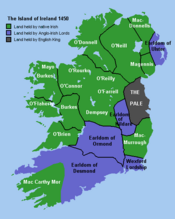
Desmond (Irish: Deasmhumhain, meaning 'South Munster') was a historic kingdom in southwestern Ireland, founded in 1118. It comprised all of what is nowCounty Corkand most ofCounty Kerry.The eastern half of Desmond was conquered by the Anglo-Normans and became the Earldom of Desmond, but the western half of Desmond lived on as a semi-independent Gaelic kingdom until 1596.
Barony of Desmond
[edit]
The House of Desmond was a branch of the famousFitzGerald Dynasty (Geraldines)in Ireland which had been founded byMaurice FitzGerald,Lord of Lanstephan in Wales ( c.1105 – c.1176). Maurice was of Anglo-Norman and Welsh descent.
Though the House of Desmond branch was founded by the eldest of Maurice FitzGeralds's sons,Thomas FitzMaurice, Lord OConnello,it became the cadet or junior branch of the family: the senior branch, the House of Kildare, was founded by Thomas's younger brotherGerald, 1st Lord of Offally.
Thomas, Lord OConello was a key supporter ofthe Lord of Pembrokeknown as ( "Strongbow" ) in his 1169invasionof Ireland. Thomas's son,John FitzThomas,became the firstBaron Desmondupon receiving, for his homage and service, a grant in 1259 of the lands ofDecies(today'sCounty Waterford) and Desmond from PrinceEdwardof England. Before passing to Edward, these lands had been held by Thomas FitzAnthony, the father ofJohn'swife Margery FitzAnthony.[1]
Earl of Desmond: first creation
[edit]The title Earl of Desmond was first created forMaurice FitzGerald, 4th Baron Desmondin about 1329.[4]
Gerald FitzGerald, 3rd Earl of Desmond,married EleanorButler.Through her,John FitzGerald, 4th Earl of Desmondand all subsequent Geraldine earls of Desmond could trace descent throughEleanor de BohuntoElizabeth of Rhuddlan,daughter of KingEdward I of Englandof theHouse of Plantagenetby his queen,Eleanor of Castileof theHouse of Burgundy.
Over time, according to English sources, the FitzGerald family became highlyassimilatedto the local Irish culture. The final Earl of Desmond of this creation wasGerald FitzGerald,the 14th Earl. The FitzGeralds and Fitzmaurices had resisted theProtestant ReformationofKing Henry VIIIand, after the failure of the first and secondDesmond Rebellions,the 14th Earl was defeated and killed by forces loyal toQueen Elizabeth Ion 11 November 1583. His title, along with the enormous estates of his family, were forfeit to theEnglish Crown.
Numbering of Earls of the first creation
[edit]Authors have numbered the earls of the first creation from 1 to 14, 1 to 15, or 1 to 16, depending on whether Nicholas, an "idiot",[5]is included as 3rd Earl, and whetherJohn, thede facto12th Earl(died 1536) andJames FitzGerald, de jure 12th Earl of Desmond(died 1540), are both numbered 12 or are numbered 12 and 13. Wikipedia numbers the earls 1 to 14 omitting the "idiot" and numbering Johnde factoand Jamesde jureboth as 12, followingCokayne(1916)[6]and theOxford Dictionary of National Biography(2004).[7][8]Burke(1866), Webb (1878) and theDictionary of national Biography(1889) admit 15, andBagwell(1885) 16 earls of the first creation.
Earl of Desmond: Second Creation
[edit]The second creation was in 1600 forJames FitzGeraldthe "Tower Earl", son of the last (14th Earl) of the first creation. He spent much of his life in captivity in theTower of London,and was obliged to convert to Protestantism. He was temporarily, but unsuccessfully, restored to the earldom in 1600–01 by the English in an attempt to pacify Munster during the Nine Years War, and to combat rise of theSúgán(pretender, see below) Earl but the people rejected the new Protestant Earl. James was not restored to the lands associated with the title, and was only given the right to the title of Earl of Desmond for life; he was also createdBaron Inchiquinwith the right to pass that title to his successors, but he did not have heirs and died in obscurity in 1601.
Pretenders to the title
[edit]James FitzThomas FitzGerald,theSúgán(Irish:straw,i.e. pretender) Earl, attempted, but failed, to regain the title during theNine Years War.James's claim was based on the fact he was the eldest grandson of the13th Earl,but he was illegitimate by descent. The 13th Earl's first marriage had to been to his own great-niece: the marriage had been declared invalid due toconsanguinityand James's father, the child of the union, had been declared illegitimate (the 14th Earl was the child of a second, legitimate marriage).
James had not joined the rebellion of the 14th Earl and following the 14th Earl's death, James lobbied the English - at first with some success - to be restored to the title. When that failed in 1598 he joined the rebellion and assumed the title of Earl of Desmond, leading eight thousand clansmen. He was captured in 1601 and is believed to have died in the Tower of London in 1608.
James's younger brother John had joined him in rebellion but escaped to Spain. Following theSúgánEarl's death John and his son Gerald continued the pretence to the title. John died in Barcelona[9]and Gerald -Conde de Desmondin Spanish - entered the service of theEmperor Ferdinand,and was killed in 1632.[9]As Gerald left no issue, with him ended the male heirs of the four eldest sons ofThomas FitzGerald, 7th Earl of Desmond:this was the effective extinction of the line of the Fitzgerald House of Desmond.
Desmond Geraldine arms and motto
[edit]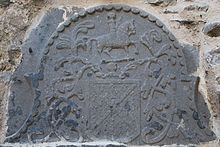
Thecoat of armsof the Geraldine Earls of Desmond,blazonedermineasaltiregules,[10]where the ermine tincture is a mark ofcadencyrelative to the seniorKildarebranch of the Geraldines (whosearmsare more simply blazoned "argent,a saltire gules "). Thecrestshows a man in armour on horseback, facing to the right.[11]
The motto appearing beneath the Desmond arms was"Shanid abu"(Shanid to victory) a reference to the Desmond stronghold ofShanid Castle.[12]
Earl of Desmond: third and fourth creation
[edit]The third creation was in 1619 forRichard Preston, 1st Lord Dingwall,who was also created Baron Dunmore.
The fourth creation happened while Preston was still alive, in 1622 forGeorge Feilding, 1st Viscount Callan,second son of the Earl of Denbigh and nephew of James I's favourite and lover, George Villiers. The eight-year-old Feilding was given the right to the title Earl of Desmond as and when Preston died without a male heir. Preston had also been a favourite and probably lover of James I; he had a daughter who, the plan was, George Feilding would marry, but this did not happen. In 1628 Preston died and George was made Earl of Desmond by Charles I (Preston's ScottishLordshipof Dingwall passed to his daughterElizabeth, the Duchess of Ormond).[13]
George Feilding's eldest son, the second Earl of Desmond, also inherited the title of third Earl of Denbigh after his uncle,the second Earl of Denbigh,died childless. The title Earl of Desmond has descended subsequently with the title Earl of Denbigh and the current holder is the twelfth Earl of Denbigh and eleventh Earl of Desmond.
List of Barons and Earls of Desmond
[edit]Barons Desmond (1259)
[edit]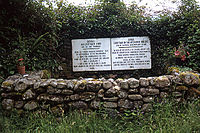
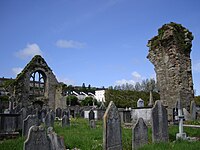
- John FitzThomas FitzGerald, 1st Baron Desmond(died 1261) (son ofThomas FitzMaurice FitzGerald)
- Thomas FitzMaurice FitzGerald, 2nd Baron Desmond(died 1298) (grandson of preceding)
- Thomas FitzThomas FitzGerald, 3rd Baron Desmond(1290–1307) (son of preceding)
- Maurice FitzThomas FitzGerald, 4th Baron Desmond(died 1356) (brother of preceding; created Earl of Desmond in 1329)
Earls of Desmond, first creation (1329)
[edit]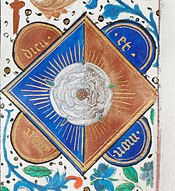
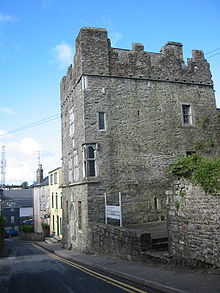


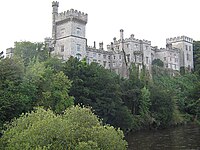
- Maurice FitzGerald, 1st Earl of Desmond(died 1356) (new creation)
- Maurice FitzGerald, 2nd Earl of Desmond(1336–1358) (son of preceding)
- Gerald FitzGerald, 3rd Earl of Desmond(died 1398) (half-brother of preceding)
- John FitzGerald, 4th Earl of Desmond(died 1399) (son of preceding)
- Thomas FitzGerald, 5th Earl of Desmond(c. 1386–1420) (son of preceding)
- James FitzGerald, 6th Earl of Desmond(died 1463) (the "Usurper," paternal uncle of preceding)
- Thomas FitzGerald, 7th Earl of Desmond(died 1468) (son of preceding)
- James FitzGerald, 8th Earl of Desmond(1459–1487) (son of preceding)
- Maurice FitzGerald, 9th Earl of Desmond(died 1520) (brother of preceding)
- James FitzGerald, 10th Earl of Desmond(died 1529) (son of preceding)
- Thomas FitzGerald, 11th Earl of Desmond(1454–1534) (paternal uncle of preceding)
- John FitzGerald, de facto 12th Earl of Desmond(died 1536) (brother of preceding, paternal granduncle ofJames FitzGerald, de jure 12th Earl of Desmond)
- James FitzGerald, de jure 12th Earl of Desmond(died 1540) (grandson ofThomas FitzGerald, 11th Earl of Desmond,grandnephew ofJohn FitzGerald, de facto 12th Earl of Desmond)
- James FitzGerald, 13th Earl of Desmond(died 1558) (son of thede facto12th Earland legitimate heir of thede jure12th Earl.
- Gerald FitzGerald, 14th Earl of Desmond(c. 1533– 1583) (son of preceding; forfeit 1582)
Pretenders to the first creation (1598-1632)
[edit]- James FitzThomas FitzGerald,theSúgán Earl,died inTower of Londonc. 1607(illegitimate grandson of 13th Earl)
- John FitzThomas FitzGerald - brother of theSúgán Earl,died Barcelona (brother of preceding)
- Gerald FitzJohn FitzGerald - son of John, known asConde de Desmond,died in service of the King of Spain, 1632 (son of preceding - no heirs)
Earls of Desmond, second creation (1600)
[edit]- James FitzGerald, 1st Earl of Desmond(1571–1601) TheTower Earl.(son of the 14th Earl). Title created as a life peerage.
Earls of Desmond, third creation (1619)
[edit]- Richard Preston, 1st Earl of Desmond(died 1628) married the great-granddaughter of 10th Earl of the first creation. (extinct)
Earls of Desmond, fourth creation (1622/28)
[edit]- George Feilding, 1st Earl of Desmond(died 1665) granted right to title on reversion, 1622; possession of title, 1628.
- William Feildng, 2nd Earl of Desmond(died 1685) inherited superior title ofEarl of Denbighin 1675.
For subsequent Earls of Desmond (title held with the title Earl of Denbigh), seeList of Earls of Denbigh and Earls of Desmond.
Notes
[edit]- ^abCokayne 1916,pp.232–258
- ^Unpublished Geraldine Documents: The Gherardini of Tuscany Author(s): A. Fitzgibbon Source: The Journal of the Royal Historical and Archaeological Association of Ireland,Jan., 1877, Fourth Series, Vol. 4, No. 29 (Jan., 1877)- page 257"Unpublished Geraldine Documents: The Gherardini of Tuscany"(PDF).JSTOR25506713.
- ^O'Clery, Michael (3 November 2023)."The Annals of Ireland of Michael O'Clery, Cucogry O'Clery, Philip MacDermott, - page 531".
- ^Cokayne 1916,pp.237–240
- ^Cokayne 1916,p.243:"Nicholas (Fitz Morice), next br. [brother] and h. [heir], aged 19 or 20 at his brother's death. He was an idiot..."
- ^Cokayne 1916,p.232–254.
- ^Cokayne 1916,p.252: "14. GERALD FITZJAMES (FITZGERALD), EARL OF DESMOND, called theRebel Earl... "
- ^McGurk 2004,p.[1].
- ^abWebb, Alfred.A Compendium of Irish Biography.Dublin: 1878.
- ^Cokayne 1916,p.237, note (a):"The arms of the earls of Desmond were, Ermine, a saltire Gules."
- ^Walter FitzGerald:Buttevant—The Franciscan Abbey.In:Journal of the Association for the Preservation of Memorials of the Dead in Ireland.Vol 6, 1904–1906, p. 443.
- ^Webb 1878,p.136, right column:"The war cry of the Desmonds was 'Shanet-a-boo!' 'Shanid [castle] to victory!'"
- ^.Page:The Complete Peerage Ed 2 Vol 4.djvu– viaWikisource.
- ^"Reginald Tower (Closed at present for essential maintenance)".
References
[edit]- Cokayne, George Edward(1916).Gibbs, Vicary(ed.).The complete peerage of England, Scotland, Ireland, Great Britain and the United Kingdom, extant, extinct, or dormant.Vol. 4 (2nd ed.). London: St Catherine Press.OCLC228661424.– Dacre to Dysart
- Debrett, John(1840). Collen, William (ed.).Debrett's Peerage of Great Britain and Ireland.London: William Pickering.
- McGurk, J. J. N. (2004)."FitzGerald, Gerald Fitz James, fourteenth earl of Desmond (c. 1533–1583)".InMatthew, Colin;Harrison, Brian(eds.).Oxford Dictionary of National Biography.Vol. 19. New York:Oxford University Press.pp. 809–811.ISBN0-19-861369-5.
- Webb, Alfred(1878).Compendium of Irish Biography.Dublin: Dublin, M.H. Gill & son. pp. 9–10.OCLC122693688.

